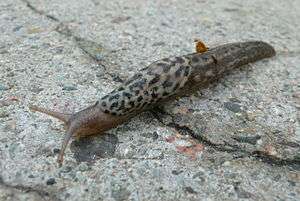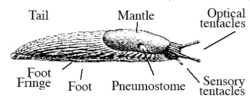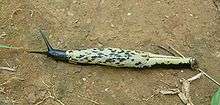Slugs
< Horticulture| Slugs | |
|---|---|
 | |
| Type: | Gastropod |
| Damaging stages: | All |
| Vulnerable stages: | All |
Slugs are gastropod molluscs without shells or with very small internal shells, in contrast to snails, which have a prominent coiled shell. The loss or reduction of the shell is a derived character, and the same basic body design has independently evolved several times, making slugs a polyphyletic group. Although they undergo torsion (180 degree twisting of internal organs) during development, their bodies are streamlined and worm-like, and so show little external evidence of it. Slugs include both marine and terrestrial species. The soft, slimy bodies of slugs are prone to desiccation, so land-living slugs are confined to moist environments.
Some species of slug are notable garden pests, and can cause considerable damage to both leafy vegetables (especially the brassicas) and "fruit vegetables" such as Tomatoes. There are various methods of controlling them. Best results may be achieved by combining several of the methods mentioned below.
Description

Slugs macerate food using their radula, a rough, tongue-like organ with many tiny tooth-like denticles.
Like snails, slugs have two pairs of 'feelers' or tentacles on their head. The upper pair--optical tentacles--are light sensors; the lower pair provides the sense of smell. Both pairs are retractable and can be regrown if lost. On top of the slug, behind the head, is the saddle-shaped mantle, and under this are the genital opening and anus. The mantle also has a hole, the pneumostome, for respiration. The slug moves by rhythmic muscular action of its foot.
Among the various species of land slug are the grey field slug, Deroceras reticulatus; the garden slug Arion hortensis; the leopard slug, Limax maximus; and the banana slug, Ariolimax columbianus.
Ecology
Most slugs eat leaves, fungus, and decaying vegetable material, but some are predators and most also eat carrion including dead of their own kind. Frogs, toads, snakes, hedgehogs, and some birds and beetles are natural slug predators. Slugs, when attacked, can contract their body, making themselves harder and more compact and thus more difficult for many animals to get a hold of. The unpleasant taste of the mucus is also a deterrent.
Slugs produce two types of mucus: one which is thin and watery, and another which is thick and sticky. Both are hygroscopic. The thin mucus is spread out from the centre of the foot to the edges. The thick mucus spreads out from front to back.
Mucus is very important to slugs as it helps them move around, and contains fibres which prevent the slug from sliding down vertical surfaces. Mucus also provides protection against predators and helps retain moisture. Some species use slime cords to lower themselves on to the ground, or suspend from them during copulation.

Slugs are hermaphroditic: having both female and male reproductive organs. Once a slug has located a mate they encircle each other and sperm is exchanged through their protruding genitalia. A few days later around 30 eggs are laid into a hole in the ground. Although some species hibernate underground during the winter in temperate climates, in other species, the adults die in the autumn.
A commonly seen practice among many slugs is apophallation, when one or both of the slugs chew off the other's penis. The penis of these species is curled like a cork-screw and often becomes entangled in their mate's genitalia in the process of exchanging sperm. Apophallation allows the slugs to separate themselves. Once the penis has been removed, the slug remains female for the rest of its life.
Various species of slug can also reproduce via tiny "darts" of sperm which they fling in the direction of their mate's genitalia.
Host plants
Slugs feed on a wide variety of garden plants, including strawberries and lettuce.
Control
- Cultural controls: Mulch provides an ideal slug habitat so mulch lightly around plants that are attractive to slugs.
- Water only in the morning so that the ground will dry by evening when slugs are naturally active.
- Prune lower leaves or stake large plants to reduce potential hiding places for slugs and allow better air circulation which helps keep the soil surface drier
- Trapping: Beer traps can be used early in the season, when the slugs' favoured foods are more scarce, as slugs are attracted to the smell of beer. Such traps have various designs, but essentially the slug will venture into a half buried jar, or cut away plastic bottle, containing a small amount of beer (not stout or lager), succumb to the fumes and drown.
- Physical removal: Night time patrols for hand collection can be useful. These can be augmented by regularly setting out traps such as boards, shingles, overturned flower pots, or grapefruit halves for slugs to hide under.
- Barriers: Slugs have an aversion to copper. Copper pipe can be used and commercial slug rings are available. A 15cm length of plastic pipe with copper foil tape around it can be used to protect individual plants.
- Repellents: Grapefruit and other citrus rinds, used coffee grounds, eggshells, and sharp sand can be used in gardens around plants to repel slugs.
- They also find dry surfaces difficult to cross since they must extrude a wet slime coat in order to move and this can eventually lead to dehydration, so leave cleared borders or walkways around plants.
- Pesticides: Commercial slug pellets containing metaldehyde or methiocarb are available, but are not approved for organic gardening as they can poison creatures at a later stage of the food chain.
- Aluminium sulfate can also be used; its proponents claim that it is less toxic to the environment.
- Salt will kill slugs, but is also poisonous to plants.
- Organic pesticides: Diatomaceous earth is a natural abrasive that can cause small cuts or scratches on slugs, causing them to dehydrate.
- Bait pellets containing iron phosphate are also used for this purpose.
- The mixture of 50% water with 50% ammonia will kill slugs instantly. This can be applied using a hand spray bottle early in the morning or during a warm rain.
- Alternate hosts: Comfrey can be used as a decoy by placing the leaves around plants to protect them. The slugs will eat the comfrey and leave the protected plant alone. This is a honeypot approach, and rarely effective as it merely increases slug populations in the longer term unless comfrey is used as a trap crop and the slugs are controlled on it.
- Predators and parasites: Frogs, toads, snakes, ground beetles, ducks, pigs, birds.
- Biocontrols (microscopic): A recent development in the control of slugs is the introduction of 'Nemaslug', a microscopic nematode (Phasmarhabditis hermaphrodita) that will seek out and parasitize slugs, reproduce inside them and kill them. The nematode is applied by watering onto moist soil, and gives protection for up to six weeks, though is mainly effective with small and young slugs under the soil surface. The nematode is only effective in warm, moist conditions, above about 20°C.
See also
References
External links
- Slug Repellent
- Slug biology
- Ohio State University slug fact sheet
- Leopard Slug Info
- Pancake Slug (Veronicella sloanei) Info
- Metaldehyde at Pesticides News
- Nemaslug commercial web site
- Slug control fact sheet at HDRA
- Slug Tape